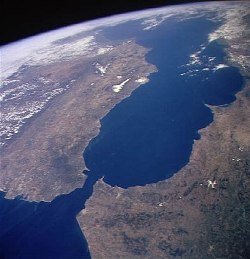
How did the Mediterranean fill up after the Straits of Gibraltar were breached? Ian Randall reports on a new model that constrains the evolution of the “Zanclean Flood”.
Geoscientist 9 February 2010
The Zanclean Flood inundated the Mediterranean Basin after the almost complete evaporation of the Mediterranean Sea in the event known as the Messinian Salinity Crisis, around 5.6 million years ago.
The exact nature of this flood, which occurred when Atlantic waters breached the present-day Straits of Gibraltar, had previously been poorly understood. It is thought that the deluge was most likely triggered by the sinking of a slab of lithosphere beneath the Betic-Rifean orogen.
Studies of boreholes and seismic surveys taken from within the Straits have revealed deep, Messinian age incisions beneath the present-day sea floor. These cuts are seen to extend over 200km laterally and exceed 250 metres in depth on both Atlantic and Mediterranean sides of the Straits. These channels were previously thought to have been generated by headward erosion by rivers and streams during the period of desiccation.
However a new study, by researchers from the Institut de Cièncias de la Terra, Jaume Almera, Spain, published in Nature, models these as being generated at the time of the flood by the gouging effect of returning Atlantic waters. This study also envisages the flood not as a thunderous Niagra-like waterfall, but like a giant “ramp” leading down from the Atlantic to the dried-out sea below.
The new model, which has enabled the researchers to estimate how long the Mediterranean Basin might have taken to become full, envisages the water’s erosive action as comparable to riverine incision. “To quantify and understand the abruptness of the post-Messinian flood we needed to incorporate the dynamics of rock incision as the mechanism that progressively excavated the floodway and let ever increasing flow of Atlantic waters into the Mediterranean basin,” the researchers write.
The researchers believe that, while a preliminary, low level discharge may have lasted for thousands of years, 90% of the flood waters were transported from the Atlantic in a period of less than two years. Such a mighty influx would, at its height, have caused sea levels in the Mediterranean to have risen by over 10 metres per day.
“Our findings suggest that the feedback between water flow and incision in the early stages of the flooding imply discharges of about a billion cubic metres per second (three orders of magnitude larger than the present day Amazon River),” the team says. They also believe that the rate of bedrock erosion may have been as fast as 0.4 metres per day.
“This is a very exciting paper”, says Imperial College’s Dr Sanjeev Gupta, who is known for his work on a similar catastrophic flood event in the English Channel. “It focuses people’s attention on the flood in more detail.” Dr Gupta hopes that this flooding model might prove to be applicable in other such deluges from geological history, adding that it would be useful to see if we “can find more flood-associated landforms and deposits from the flood.”
The oceans do not provide the only examples of megafloods – overflows from many large lakes have had a sizable impact on their local topography: such as Utah’s former Lake Bonneville, and the Ebro basin in Spain. However, the Zanclean event is unique in both the size of the source basin, and of the eventual sink.
Evidence for the cyclic desiccation of the Mediterranean Sea has come from the presence of deep (up to 2500m) fluvial canyons that were carved into the empty seabed during the Messinian, when water levels were around a kilometre lower. Similar evidence is also found in the salt deposits from the centre of the basin, which can be found in outcrop in Italy, Libya and Sicily. Messina, which is in Sicily, gave its name to the salinity crisis.
Ref: Nature 462, 778-781 (10 December 2009) Catastrophic flood of the Mediterranean after the Messinian salinity crisis. D. Garcia-Castellanos, F. Estrada, I. Jiménez-Munt, C. Gorini, M. Fernàndez, J. Vergés & R. De Vicente1